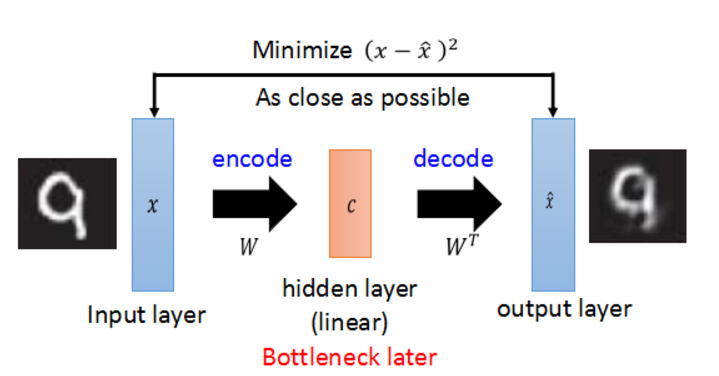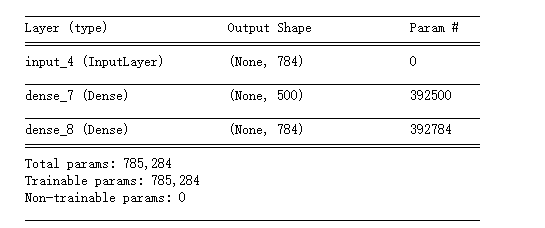Keras实现autoencoder
Keras使我们搭建神经网络变得异常简单,之前我们使用了Sequential来搭建LSTM:keras实现LSTM。
我们要使用Keras的functional API搭建更加灵活的网络结构,比如说本文的autoencoder,关于autoencoder的介绍可以在这里找到:deep autoencoder。
现在我们就开始。
step 0 导入需要的包
1 import keras 2 from keras.layers import Dense, Input 3 from keras.datasets import mnist 4 from keras.models import Model 5 import numpy as np
step 1 数据预处理
这里需要说明一下,导入的原始数据shape为(60000,28,28),autoencoder使用(60000,28*28),而且autoencoder属于无监督学习,所以只需要导入x_train和x_test.
1 (x_train, _), (x_test, _) = mnist.load_data() 2 x_train = x_train.astype('float32')/255.0 3 x_test = x_test.astype('float32')/255.0 4 #print(x_train.shape) 5 x_train = x_train.reshape(x_train.shape[0], -1) 6 x_test = x_test.reshape(x_test.shape[0], -1) 7 #print(x_train.shape)
step 2 向图片添加噪声
添加噪声是为了让autoencoder更robust,不容易出现过拟合。
1 #add random noise 2 x_train_nosiy = x_train + 0.3 * np.random.normal(loc=0., scale=1., size=x_train.shape) 3 x_test_nosiy = x_test + 0.3 * np.random.normal(loc=0, scale=1, size=x_test.shape) 4 x_train_nosiy = np.clip(x_train_nosiy, 0., 1.) 5 x_test_nosiy = np.clip(x_test_nosiy, 0, 1.) 6 print(x_train_nosiy.shape, x_test_nosiy.shape)
step 3 搭建网络结构
分别构建encoded和decoded,然后将它们链接起来构成整个autoencoder。使用Model建模。
1 #build autoencoder model 2 input_img = Input(shape=(28*28,)) 3 encoded = Dense(500, activation='relu')(input_img) 4 decoded = Dense(784, activation='sigmoid')(encoded) 5 6 autoencoder = Model(input=input_img, output=decoded)
step 4 compile
因为这里是让解压后的图片和原图片做比较, loss使用的是binary_crossentropy。
1 autoencoder.compile(optimizer='adam', loss='binary_crossentropy') 2 autoencoder.summary()

step 5 train
指定epochs,batch_size,可以使用validation_data,keras训练的时候不会使用它,而是用来做模型评价。
autoencoder.fit(x_train_nosiy, x_train, epochs=20, batch_size=128, verbose=1, validation_data=(x_test, x_test))
step 6 对比一下解压缩后的图片和原图片
1 %matplotlib inline 2 import matplotlib.pyplot as plt 3 4 #decoded test images 5 decoded_img = autoencoder.predict(x_test_nosiy) 6 7 n = 10 8 plt.figure(figsize=(20, 4)) 9 for i in range(n): 10 #noisy data 11 ax = plt.subplot(3, n, i+1) 12 plt.imshow(x_test_nosiy[i].reshape(28, 28)) 13 plt.gray() 14 ax.get_xaxis().set_visible(False) 15 ax.get_yaxis().set_visible(False) 16 #predict 17 ax = plt.subplot(3, n, i+1+n) 18 plt.imshow(decoded_img[i].reshape(28, 28)) 19 plt.gray() 20 ax.get_yaxis().set_visible(False) 21 ax.get_xaxis().set_visible(False) 22 #original 23 ax = plt.subplot(3, n, i+1+2*n) 24 plt.imshow(x_test[i].reshape(28, 28)) 25 plt.gray() 26 ax.get_yaxis().set_visible(False) 27 ax.get_xaxis().set_visible(False) 28 plt.show()
这样的结果,你能分出哪个是压缩解压缩后的图片哪个是原图片吗?

reference:
https://keras.io/getting-started/functional-api-guide/






【推荐】国内首个AI IDE,深度理解中文开发场景,立即下载体验Trae
【推荐】编程新体验,更懂你的AI,立即体验豆包MarsCode编程助手
【推荐】抖音旗下AI助手豆包,你的智能百科全书,全免费不限次数
【推荐】轻量又高性能的 SSH 工具 IShell:AI 加持,快人一步
· 从 HTTP 原因短语缺失研究 HTTP/2 和 HTTP/3 的设计差异
· AI与.NET技术实操系列:向量存储与相似性搜索在 .NET 中的实现
· 基于Microsoft.Extensions.AI核心库实现RAG应用
· Linux系列:如何用heaptrack跟踪.NET程序的非托管内存泄露
· 开发者必知的日志记录最佳实践
· TypeScript + Deepseek 打造卜卦网站:技术与玄学的结合
· Manus的开源复刻OpenManus初探
· 写一个简单的SQL生成工具
· AI 智能体引爆开源社区「GitHub 热点速览」
· C#/.NET/.NET Core技术前沿周刊 | 第 29 期(2025年3.1-3.9)